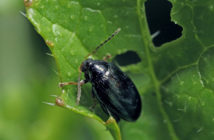Making OSR variety choices based on the conditions in which they are to be grown is fundamental to a profitable crop, and this comes down to understanding how the genetics or traits within that variety help to protect the top-line yield from the host of environmental and crop management factors that are known to depress yield, says Dr Vasilis Gegas, Limagrain’s senior oilseed rape breeder.
“When choosing to grow a new variety, seed yield and gross output based on AHDB Recommended List figures are often the hook, however these figures are hard to replicate on farm and this is down to the erosion of this top-line yield once a variety is in a field situation.”
A combination of factors, such as disease pressure, environmental conditions, agronomic practices and crop management broadens the gap between the genetic yield potential of a variety and the realised performance on farm,” he says.
“The reality is that we don’t know what the next season is going to throw at us there are so many unknowns in this game, from grain prices, weather patterns, disease pressure and even the impact of Brexit, so start by minimising risk wherever possible by choosing the right variety and making the most of the agronomic characteristics on offer.”
Limagrain’s dedicated UK OSR breeding programme based in Rothwell, Lincs is unique in that it focusses specifically on challenges that UK OSR growers face. “Loss of chemistry to control aphids and associated yield losses, the spread of club root and light leaf spot into non-traditional regions, and of course difficulties with establishment, are all issues that can be tackled through the right genetics.”
“We look at how best we can combine a range of traits so that we are able to offer varieties that suit particular situations. For example, growers in the north are looking for OSR crops that will establish quickly so need to demonstrate early vigour, winter hardiness, early maturity and have robust disease resistance against Light Leaf Spot.”
However these genetics need to be rigorously tested in the conditions to which they will be launched, to know if they will perform consistently, points out Dr Gegas. “We are able to test all our varieties for a number of years under UK conditions, which means that we are confident that we are bringing the most appropriate and consistent varieties to market.”
Genetic traits
With the loss of neonicotinoid seed treatments and increasing resistance to insecticides as well as the difficulties of optimising foliar insecticide applications, control of aphids has become more and more difficult and subsequently aphid-borne diseases more prevalent.
TuYV is one such disease spread by the peach potato aphid (Myzus persicae). TuYV infection can reduce yields in OSR by as much as 30%, oil content by 3% whilst increasing levels of glucosinolates and erucic acid.
Resistance to TuYV is a trait that has been pioneered by the Limagrain OSR breeding programme, and the inclusion of this trait in OSR varieties has been proven to mitigate yield losses particularly in high infection situations, notes Dr Gegas.
Limagrain’s Amalie was the first variety to carry this resistance back in 2014, and since then Annalise (RL UK candidate), has been brought to market, offering a much higher yield and an impressive oil content (46.9%), way above that of Amalie.
Limagrain has also introduced the TuYV resistance trait into the RL candidate hybrid, Architect. Along with characteristics such as pod shatter resistance, winter hardiness and excellent autumn vigour, the high potential yield of Architect is locked in and protected – as has been shown in trials results from across the country where the variety has yielded 105% in the east/west and 104 in the north.
“We have been able to eliminate the yield penalty associated with the introduction of the TuYV resistance into OSR. Our new TuYV resistant varieties therefore have high yield potential and the necessary traits and agronomic characters that enable the crop to reach and maintain that potential on farm.”
“Our target has always been to deliver cutting edge scientific innovations to farm through precision breeding, and this is exactly what UK farmers get, real solutions to real problems.”
We know that the levels of TuYV incidence are associated with the distribution of aphids in the autumn before, says Dr Gegas. “Levels of aphids in the autumn of 2016 were at similar levels to 2014, which was a high infection year, so we could be looking at some very high TuYV infection levels this year.”
Limagrain carries out an annual TuYV survey of which the results will be available later next month, he confirms.
Pod Shatter (POSH) resistance is a trait that all new Limagrain OSR hybrid varieties offer. On farm, significant OSR seed loss can be caused when pods break or shatter as a result of storms near harvest or even when the combine passes through the crop.
“POSH resistance can help to counteract these losses, as well as providing some flexibility in the timing of the harvest, which can be as much as 14 days extra in our tests,” he says. “In addition, a robust POSH resistance cuts down the number of volunteers in the following crop, easing the burden of weed control.”
Dr Gegas points out that not all hybrids have POSH resistance, as in some cases the trait has been lost in the breeding process. “However, we have developed the necessary genetic tools and analytical methods to introduce the trait into our varieties and to precisely quantify POSH resistance to ensure that our varieties carry a high level of resistance.”
Limagrain’s hybrids Aquila, Architect and Arrow offer very high levels of pod shatter resistance and this plays out in the high yields of all three varieties.
Club Root
Club root is becoming an increasing threat to OSR performance across the UK, so breeding for new sources of resistance is more important than ever, says Dr Gegas.
“We have invested significant effort into our breeding programme to overcome the yield penalties associated with club root resistant varieties.”
“We are particularly excited about our hybrid variety, Archimedes that offers a gross output of 99% as well as POSH resistance and an excellent disease resistance profile (8 for canker and 6 for LLS).
“With its stiff stem, exceptional early vigour and early maturity, Archimedes offers the best available package for the traditional club root growing areas of Scotland, but also infected land further south.”
“The Limagrain OSR breeding programme will soon deliver its first Clearfield hybrid, Conrad, to market next year,” adds Dr Gegas.
Limagrain candidate and certified OSR varieties and associated traits
|
Variety |
Status |
POSH |
RLM7 |
TuYV |
Club Root |
|
ARCHITECT |
Candidate UK |
|
|
|
|
|
ARROW |
Candidate UK |
|
|
|
|
|
AQUILA |
RL E/W |
|
|
|
|
|
ARCHIMEDES |
NL |
|
|
|
|
|
AMALIE |
RL UK |
|
|
|
|
|
ANNALISE |
Candidate UK |
|
|
|
|



